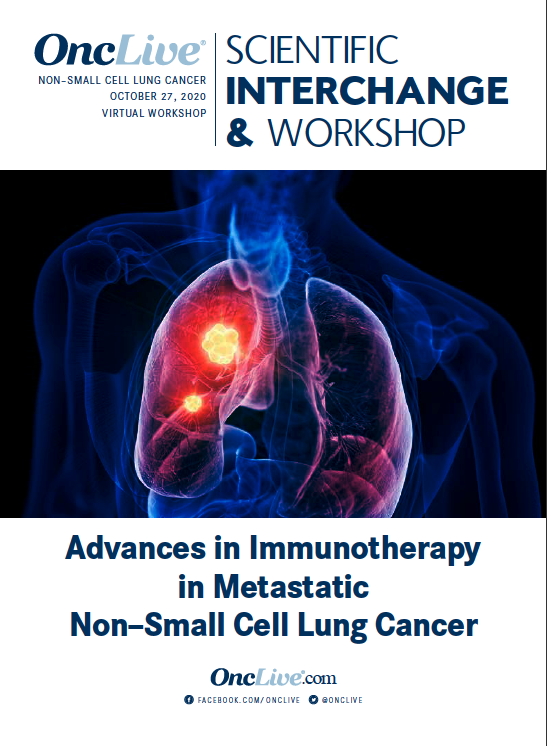Expert Perspectives on Promising Data Discussed at the Immunotherapy Non–Small Cell Lung Cancer Workshop
Sarah Goldberg, MD, MPH, discusses a network meta-analysis of randomized trials of chemoimmunotherapy with in patients with advanced disease, data suggest that certain populations with high, and perhaps low, PD-L1 expression may not require combination therapy, which would minimize adverse event potential.
Sarah B. Goldberg, MD, MPH

In a network meta-analysis of randomized trials of chemoimmunotherapy with in patients with advanced disease, data suggest that certain populations with high, and perhaps low, PD-L1 expression may not require combination therapy, which would minimize adverse event potential. The investigators, including key author Sarah Goldberg, MD, MPH, examined the use of PD-1 and PD-L1 inhibitors in patients with untreated brain metastases and found that 30% of patients treated with pembrolizumab had response, suggesting that radiation may be avoidable in certain populations. In addition, for patients with metastatic disease and high PD-L1 expression, the EMPOWER-Lung 1 trial showed that cemiplimab proved highly effective compared with chemotherapy.
OncLive®: What are the key highlights from the network meta-analysis of randomized trials comparing chemoimmunotherapy with immunotherapy in patients with advanced non–small cell lung cancer (NSCLC)?
Goldberg: The reason that we did that study was that all of these trials that we’re seeing now that have changed our practice and our way of treating patients with advanced lung cancer have compared an immunotherapy-based regimen with chemotherapy alone. So far, we have no clear data that any one of those regimens is better than the other in a head-to-head comparison.
And so we undertook this network meta-analysis to look at the data from these various studies to try and tease out what might be the best treatment for various subsets of patients based on PD-L1 status. I think what we’re starting to see is that, in some patients, single-agent immunotherapy might be sufficient—that high PD-L1 [expression] may not require combination therapy and [that perhaps] even low PD-L1 expression [in] the 1% to 49% [range may not either]. At least in our meta-analysis, it wasn’t clear that chemotherapy plus immunotherapy had better survival than immunotherapy alone.
Again, this is a meta-analysis; it’s not randomized data. Randomized trials are ongoing [that] will answer that question more definitively. But I think [we’re] starting to get at the question of, “Well, we have all these regimens, but which one is actually the best to use for any individual patient?”
What are some of the unmet needs in patients with metastatic disease?
[For] some patients with metastatic disease, when we treat them in the first line, whether it’s single-agent pembrolizumab, single-agent atezolizumab, or a combination with chemotherapy and immunotherapy...Some patients do incredibly well, and they have a great and durable response, which I think is why so many of us are excited about immunotherapy. It provides us potential for a very long-term response and long-term survival.
But it would be nice to understand why these patients are progressing [and] why the disease is either no longer responding or never responded [so that we could] then treat them in a smart, personalized way. But we’re not there yet—where...the mechanism of resistance can be discovered and then we can treat based on that. So that is a huge area of need—where we understand why the resistance is occurring and how to overcome it.
OncLive®: You were an author on a study examining the use of PD-1 and PD-L1 inhibitors in patients who have NSCLC and brain metastases. What has been found in that study so far?
[This] is a phase 2 study that we did here at Yale [University]. We looked at patients who had brain metastases, and instead of giving them the standard of local therapy, we treated them with pembrolizumab and watched the brain MRIs very closely to make sure that they were safe and [assessed] for progression or response to treatment. We found that about 30% of patients with PD-L1–positive tumors, so at least 1% or [more], did have a response in their brain metastases. It really showed that patients can respond in the brain; that was really unknown before.
I think it gives us some confidence that if we would like to avoid radiation for whatever reason—or in a patient with small, untreated brain metastases—maybe we can hold off on local therapy if we think the patient has a good chance of response, particularly for [those with] high PD-L1 [status] and the patients we think have a good, high chance of response.
This gave us some insight into the potential benefit in the brain. But still, not all patients respond in the brain, and some patients who do end up progressing at some point in the brain. And so that is, again, another area of need: We have to understand how best to treat patients with brain metastases. There hasn’t been a randomized study to tell us that it’s best to give immunotherapy alone or [that] it’s better to give radiation first and then immunotherapy. Or do we give them together? What about the timing?
What was the role of cemiplimab in NSCLC in the EMPOWER-Lung 1 trial?
This is another trial that showed us the benefit of immunotherapy for patients with metastatic non–small cell lung cancer. This trial compared single-agent cemiplimab, a PD-1 inhibitor, with chemotherapy, [and it] showed a survival benefit. I think—and this is with high PD-L1—that this looks like a very effective drug compared with chemotherapy; it clearly had a benefit.
Pembrolizumab has been our standard for several years now. Atezolizumab also has shown benefit compared with chemotherapy. And then, of course, we have the combination. So I think it may be another tool that we can use, but exactly how we choose which is best is still unclear to me at this point.
What is your approach to choosing between a single-agent or combination immunotherapy regimen in this space?
I think it is still really important to get [PD-LI expression], mainly because the high PD-L1 expressors, the greater-than-50% population, can have very significant and durable benefit from single-agent immunotherapy, whether it’s [pembrolizumab], [atezolizumab, or] cemiplimab. Which one you choose is a harder question.
That’s really the main reason, in my mind, to still look at PD-L1 expression—because you might be able to get away with treating patients with a single agent, which is really nice. There’s less toxicity. And if someone is responding, it’s clear-cut what they’re responding to. When you give combinations, it is more confusing. So I think that is really the main reason to get PD-L1 expression.
For a while we had chemotherapy and immunotherapy with platinum, pemetrexed, and pembrolizumab as our only other option, [besides carboplatin/taxane and pembrolizumab], for patients with squamous cell disease. But now there are several other combination options. There are data with chemo plus bevacizumab and [atezolizumab]. And now more recent combination immunotherapy trials have shown benefit of [nivolumab] plus ipilimumab and then chemo plus [nivolumab] plus [ipilimumab].




